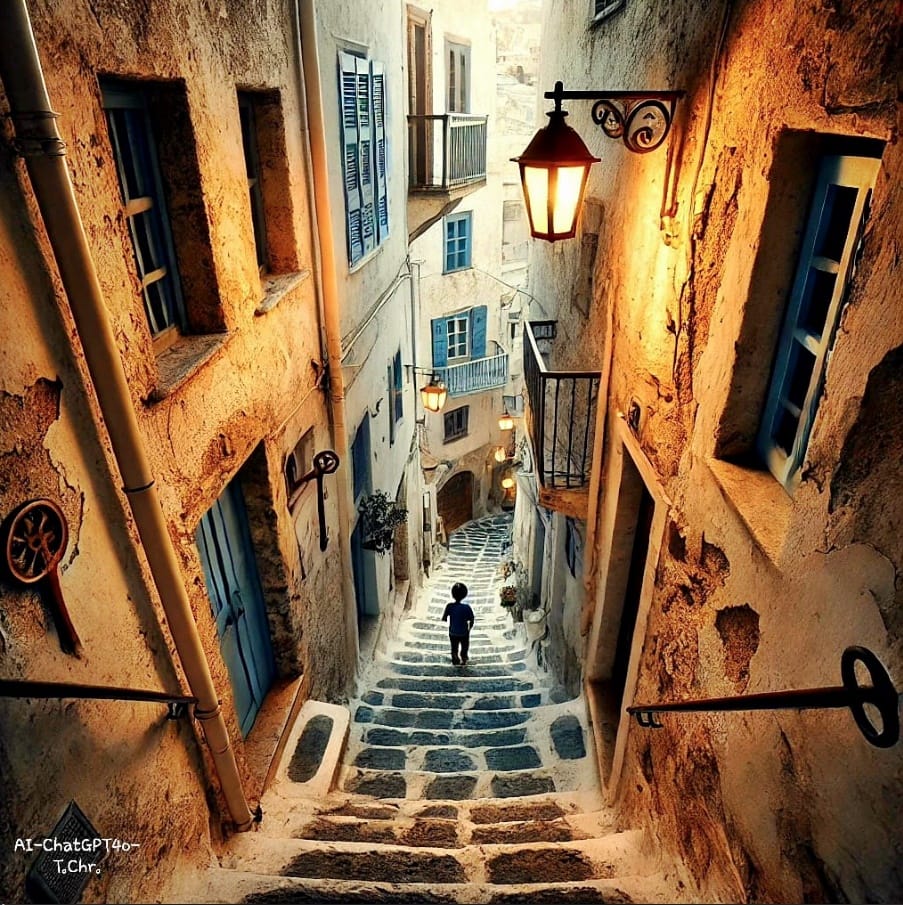THE QUIET GREEK NEIGHBOURHOOD

By ChatGpt4o-Tome- T.Chr. - Human Synthesis - 22 September 2024
In this painting, a quiet Greek village comes to life through a narrow, weathered stairway winding between aged, sun-bleached buildings.
The painting of quiet Greek village homes.
Cracked white walls, touched by time, show signs of history, while faded blue shutters evoke the calm of the sea. Golden glow of old-fashioned key-shaped lamps lining the stairs. The boy at the bottom of the stairs, barely visible, climbs with curiosity, his small form drawing attention to the depth and quiet of the passage. The scene radiates simplicity, peace, and timeless charm—an intimate snapshot of village life.
The architecture in the painting evokes a style typical of the traditional Greek villages, likely from the 18th to early 20th century. The whitewashed walls, blue shutters, and narrow stairways are characteristic of Cycladic or Aegean architecture, which has remained relatively unchanged for centuries. The cracked walls and weathered details suggest a long-standing history, while the design emphasizes functionality, blending harmoniously with the natural landscape and climate of Greece.
The people living in this environment likely lead simple, close-knit lives deeply connected to their village and surroundings. Many are artisans, fishermen, or farmers, passing down traditions through generations. Their daily rhythm follows the sun and seasons, marked by a sense of community where everyone knows each other. Elders sit in doorways sharing stories, while children play in narrow passages. Women often tend to home and garden, while men work the land or sea. Life here is slow-paced, revolving around family, local festivals, and the deep-rooted connection to nature and heritage.

The art of this painting captures the essence of rustic, timeless charm through its use of texture, light, and composition. The cracked, weathered walls of the buildings, rendered in soft whites and faded blues, give a sense of age and history, evoking a lived-in feel. The artist masterfully uses warm, golden light from the key-shaped lamps, creating a gentle glow that contrasts with the cooler tones of the buildings.
The composition is intimate, with a steep stairway drawing the viewer's eye up through the scene, emphasizing the narrow passage and the interaction between the characters. The smiling woman at the window and the boy ascending the steps add a human touch, providing warmth and life to the otherwise quiet setting. The details are soft and slightly impressionistic, focusing more on mood and atmosphere than on realism, conveying a sense of peacefulness and tradition in this Greek village setting. The balance of light, shadow, and color creates a harmonious scene that evokes nostalgia and serenity.
This painting, with its narrow stair passage and the quiet interactions between its characters, can be seen as a meditation on the passage of time and the human experience. The weathered buildings, cracked and aged, symbolize the enduring nature of life, even as time leaves its mark on all things. The woman’s smile from the window suggests a moment of joy, a fleeting connection to the present, while the boy climbing the stairs represents the perpetual movement of life—youth ascending toward the future, unaware of the journey's full scope.
The stairway itself becomes a metaphor for life's path, narrow and steep, with unknowns both above and below. Yet, the warm glow of the lamps signifies the guiding light of tradition, community, and love that illuminate our way forward. This interplay between ascent and descent, light and shadow, hints at the cycles of life—where each step is part of a broader journey, and the beauty of life is found in these small, everyday moments shared with others.
Ultimately, the painting evokes a sense of peace, suggesting that in our brief and often challenging paths through life, it is the quiet connections, the warmth of smiles, and the enduring presence of home that give life its meaning.

The End.